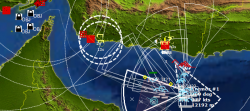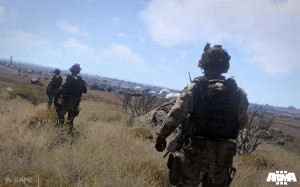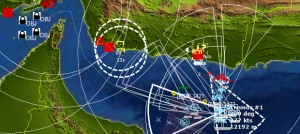By Jon Paris
The United States Navy’s surface fleet finds itself in dynamic times. The standard length for deployments continues to rise, numerous hulls are on the chopping block, maintenance is battling to keep up with a harried operational tempo, and as ever, its leaders – Surface Warfare Officers, or SWO’s – are struggling to both improve, and in fact define, the community’s identity. Whether it is the uniforms we wear, our training pipelines, or our often-mocked culture, the community seems to lack a firm grasp on who we are, what we stand for, and how we do business. Over a series of three articles, I intend to first analyze a few counterparts – the Royal Navy, U.S. Naval Aviation, and U.S. Navy surface nuclear officers – and then explore some proposals meant to solidify the officers who take the world’s most powerful ships to sea.

After working alongside the Royal Navy, most American surface warriors walk away immensely impressed by the impeccable professionalism of their British counterparts. When SWO’s talk about improving their community, the Royal Navy’s practices inevitably come up. “We should do it like the Brits,” is a common theme. Few truly appreciate what that statement means, though. The Surface Warriors of the U.S. and Royal Navies are different: in size, mission sets, tempos, training, and priorities. There is not always a one-for-one correlation between the two. Before analyzing proposals or judging the merits of each side, let us simply gather some information by comparing the lifestyles of Sub Lieutenant Snodgrass, RN, and Ensign Timmy, USN.
The first area of comparison is training and path to qualification. All Royal Navy officer cadets spend between six and eleven months at Britannia Royal Naval College (BRNC), where students receive military indoctrination and learn the ins and outs of the naval profession through a standardized curriculum. Upon graduation from BRNC, the young surface officer proceeds on to a training track for Warfare Officers or Engineers. The prospective engineers endure a rigorous 20-month pipeline of practical and theoretical training.

Our Sub Lieutenant Snodgrass is a Warfare Officer, which is the career track most comparable to an American SWO’s. He and his comrades train for an additional 18-months. First, they attend three months of advanced seamanship theory training, followed by an intense year of practical bridge watch standing under instruction. If they are successful to this point, they stand for a week of individual bridge simulator assessments. Students must achieve passing marks on these assessments to proceed on to a final three months of advanced seamanship and navigation training. Upon graduation, they report aboard their first ship as an Officer-of-the-Watch (OOW) with a well-earned Navigational Watch Certificate. Within a month or so, SLt Snodgrass has earned his Commanding Officer’s Platform Endorsement – akin to a SWO’s Officer-of-the-Deck Underway Letter – and is entrusted with operating the ship unsupervised. While some Warfare Officers attend a 4-month long course and become navigators after gaining at least 4 years experience as an OOW, the next major pipeline for now-LT Snodgrass is the Principal Warfare Officer (PWO) Course and occurs at the nine-year point. Thirteen months long, the PWO Course trains Royal Navy surface officers to be the Commanding Officer’s advisor on either “Above Water” or “Under Water” Warfare, and can see up to 40 percent attrition.

The U.S. Navy SWO training pipeline has seen several iterations over the past 12 years. Before 2003, newly commissioned Surface Warfare Officer Trainees attended the six month-long Division Officer’s Course. SWOSDOC, as the course was called, taught the basics of ship handling, navigation, shipboard maintenance, damage control, leadership, and divisional administration. The objective of the course was to give all ensigns the tools necessary to immediately contribute to their wardrooms and a foundation from which to qualify aboard their ship. This course was disbanded in 2003 and for approximately nine years, new officers reported directly to their ships, took over their divisions, completed computer-based modules, and received on-the-job training as they progressed through their qualifications. The current training model sees new officers attending an 8-week Basic Division Officer Course (BDOC) in their Fleet Concentration Area, where they delve into many of the topics found in the old SWOSDOC program.
Upon completion of BDOC, ensigns report to their ships and are assigned a division of anywhere between 10 and 30 Sailors to lead and the associated responsibility of the maintenance of their division’s systems. Concurrent with their division officer duties, they embark on a journey to earn their Surface Warfare Officer designation and pin. This journey, nominally 18-months long, entails qualifying in a series of watch stations – namely, Officer-of-the-Deck In-Port, Small Boat Officer, Combat Information Center Watch Officer, Helm and Aft-Steering Safety Officer, and ultimately, Officer-of-the-Deck Underway – through the completion of Professional Qualification Standards (PQS) books and various oral boards. The milestone pre-requisite to the SWO Pin is the Officer-of-the-Deck Underway letter – similar to the Royal Navy’s Platform Endorsement – and usually comes after about a year aboard the ship and ultimately represents the Captain’s trust in the officer to safely and professionally operate the ship in their stead.
Typically, our Ensign Timmy will accumulate another six months of experience leading his bridge watch team, his division, and learning the catch-all nature of his chosen trade before sitting for his “SWO Board.” The SWO Board is a memorable event and involves the candidate sitting across from what, at the time, seems like a firing squad made up all of the department heads, the executive officer, and the Captain. While there is no formal, written or otherwise, fleet standard (outside of the pre-requisite watch stations) and no tangible result (aside from the pin), the SWO qualification represents a junior officer’s journeyman-level grasp of the surface, naval, and joint profession. Topics covered range far-and-wide: from logistics matters to amphibious landings and missile engagements, to personnel records, geography, ship and aircraft capabilities, emergency procedures, and naval justice fundamentals to meteorology. Now, with a pin and new officer designator, Lieutenant Junior Grade Timmy completes his first tour and attends approximately 1-2 months of job specific training before reporting to his next ship for a two year tour as Navigator, Auxiliaries officer, Main Propulsion Assistant, Fire Control Officer, Training Officer, Anti-Submarine Warfare Officer, or Force Protection Officer.
At the 8-year point, prospective SWO Department Heads attend up to nine weeks of intensive training in combat systems fundamentals, followed by 6-months in the Department Head Course, which includes three months dedicated to maritime warfare, and three months dedicated to administration, maintenance, damage control, and topics unique to the officer’s future billet.

The next point of comparison is more overt and was touched on briefly above. In the Royal Navy, recruits select and compete for a specialization before attending the Royal Navy College. They attend training either for Warfare Officers, Marine Engineers, Weapon Engineers, or Air Engineers. Warfare Officers are first responsible for bridge watch standing and safe navigation, and later in their careers for the tactical employment of the ship’s combat systems. Their engineers are responsible for leading the ship’s technicians and the upkeep of their respective kit – or in U.S. Navy terms, the preventative and corrective maintenance of their assigned shipboard systems. SLt Snodgrass, our Royal Navy Warfare Officer, will start his career with three tours as a bridge watch keeper. Later on, he serves two tours as a Principal Warfare Officer. His engineer counterparts – either marine or weapon – leave their training and serve a tour as a shipboard Deputy Head of Department, where they ultimately sit a professional board qualifying them as capable of leading a department. After engineering focused “shore drafts,” those who qualify return to sea as Heads of Department.
In the U.S. Navy, Surface Warfare Officers do not formally specialize in their billets. The community prides itself in producing Jacks-of-all-Trades. Ensign Timmy starts his career as a SWO by serving two division officer tours. He has little to no say in what his first billet will be – he could just as easily serve as the Electrical Officer as he could the Gunnery or Communications Officer. When proceeding to his next tour, his desires and performance are taken into account along with the ever-present needs of the Navy. En route to his second ship, LTJG Timmy receives his first formalized billet training. His second division officer tour may or may not fall under the same department as his first. After four years ashore, now-LT Timmy serves two 18-month Department Head tours. While his desires are given heavy weight, his assignment will not necessarily be to a department in which he previously served. The career experiences, training, and development of SWO’s is designed to ensure that they are notionally plug-and-play – able to serve in any capacity at a moment’s notice. The U.S. Navy does not have a direct comparison to the Royal Navy’s Marine and Weapons Engineers, though in our system, they would most closely be seen as a mix of our Limited Duty Officers and Department Heads.
A final point of comparison is the Royal Navy’s focus on watch-standing over billets in their Warfare Officer community. On a typical Type-23 Frigate, their Warfare Officers will fill the roles of the four Officers-of-the-Watch, Navigator, PWO Underwater, PWO Abovewater, Operations Officer, Executive Officer, and Captain. Other billets, including Weapon Engineer Officer, Marine Engineer Officer, and their deputies, are filled by specialized engineering officers.
The primary duty of SLt Snodgrass, as an assigned Officer-of-the-Watch and later a Principal Warfare Officer, is watch keeping. Officers-of-the-Watch are also assigned secondary duties like Classified Books Officer, Intelligence Officer, and XO’s Assistant. They are also responsible for the pastoral care of a group of Sailors. While leadership and special duties are a reality for the Warfare Officer, it is a fact of life that they come second to their job as professional watch standers. This fact was driven home to me by one Royal Naval Officer who said, “an OOW is a prime target for secondary duties… then we encounter an incident, and a casual factor is found to be that the OOW was distracted from their core task of watch-keeping, and an admiral directs a high-pressure blast getting rid of many of them (secondary duties).” Junior PWO serve as their Captain’s advisors on warfare and as the lead watch-stander in their Operations Room. When not standing watch and serving as a warfare advisor, they serve as shipboard staff, execute event planning, and serve in what the U.S. Navy might consider a special projects officer capacity, in addition to the pastoral care of the junior officers in their wardroom.
Surface Warfare Officers are detailed, or assigned, to a specific shipboard billet. This billet is not only on their orders, but also serves as their very identity aboard the ship. They are the Gunnery Officer – GUNNO – or the Chief Engineer – CHENG. As a division officer, Ensign Timmy spends his day seeing to his division’s Sailors, equipment, and operations, while also standing roughly ten hours of watch per day, whether that be on the bridge, in Combat, or in the engineering plant. Later on, Lieutenant Timmy leads a department of approximately three divisions. While serving as a Department Head, he qualifies and stands watch as Tactical Action Officer, leading the watch team tasked with employing the ship’s sensors and weapons and serving as the senior watch stander aboard the ship. Watches are not collateral for SWO’s, yet their professional bias is most certainly towards their billet and their people.
One key difference between the two navies that creates this disparity in bias is their respective approaches to duties covered by officers – specialists or not – vice enlisted Sailors. In the Royal Navy, most of the day-to-day upkeep of a division’s personnel and spaces is delegated to a senior petty officer. The Royal Navy also uses officers in many watch stations, like Quartermaster-of-the-Watch (duties considered a core competency of an RN OOW), Air Intercept Controller (Fighter Director in the RN), and Anti-Air Warfare Coordinator, that the U.S. Navy either mans with senior petty officers and chiefs, or splits between enlisted and commissioned watch standers. As a Royal Navy PWO broke it down for me, “tactical advice on Anti-Submarine Warfare (ASW) is my job as PWO(U), planning ASW matters is my chief’s job, looking after the ASW ratings is my petty officer’s job with direction from the two levels above, and maintenance of the ASW kit is the Deputy Weapon Engineering Officer’s job.” In the U.S. Navy, while surface Sailors are certainly empowered through delegation, a division officer or department head would have their hands in all of those levels in the execution of their assigned billet, while also concurrently standing watch throughout a given day.
Undoubtedly, each country could take something positive away from the other for their own betterment. Our unique cultures and operational commitments, as well as our relative sizes, certainly drive our respective methods. Now that we have a better understanding of how the Royal Navy does business, we can draw rough comparisons to the American Surface Warfare Officer community and start to imagine elements we might adopt as we endeavor for self-improvement. Before exploring specific proposals, though, my next piece in this series will again seek to inform by comparing the professional standards, training mindset and approach to attrition of the SWO community with that of both Naval Aviation and nuclear trained officers.
Read the next installment here.
Lieutenant Jon Paris is a U.S. Navy Surface Warfare Officer. At sea, he has served aboard both a destroyer and cruiser, in both Weapons and Navigation Department. Ashore he has served as a Navigation Instructor at the U.S. Naval Academy and as a Flag Aide. He is a prospective destroyer Operations Officer. His opinions and generalizations are his own and do not reflect official stances or policy of the U.S. Navy.













